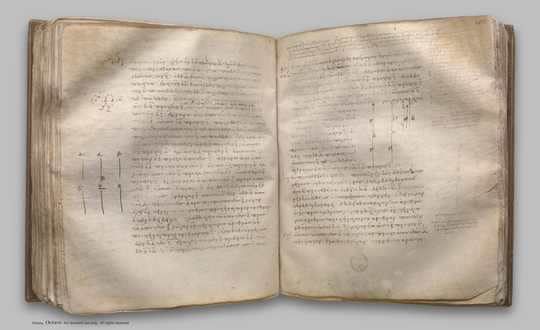index prev next | digilib folio 189

To find two straight lines incommensurable, the one in length only, and the other in square also, with an assigned straight line.
| Τῇ προτεθείσῃ εὐθείᾳ προσευρεῖν δύο εὐθείας ἀσυμμέτρους, τὴν μὲν μήκει μόνον, τὴν δὲ καὶ δυνάμει. Ἔστω ἡ προτεθεῖσα εὐθεῖα ἡ Α: δεῖ δὴ τῇ Α προσευρεῖν δύο εὐθείας ἀσυμμέτρους, τὴν μὲν μήκει μόνον, τὴν δὲ καὶ δυνάμει. Ἐκκείσθωσαν γὰρ δύο ἀριθμοὶ οἱ Β, Γ πρὸς ἀλλήλους λόγον μὴ ἔχοντες, ὃν τετράγωνος ἀριθμὸς πρὸς τετράγωνον ἀριθμόν, τουτέστι μὴ ὅμοιοι ἐπίπεδοι, καὶ γεγονέτω ὡς ὁ Β πρὸς τὸν Γ, οὕτως τὸ ἀπὸ τῆς Α τετράγωνον πρὸς τὸ ἀπὸ τῆς Δ τετράγωνον: ἐμάθομεν γάρ: σύμμετρον ἄρα τὸ ἀπὸ τῆς Α τῷ ἀπὸ τῆς Δ. καὶ ἐπεὶ ὁ Β πρὸς τὸν Γ λόγον οὐκ ἔχει, ὃν τετράγωνος ἀριθμὸς πρὸς τετράγωνον ἀριθμόν, οὐδ' ἄρα τὸ ἀπὸ τῆς Α πρὸς τὸ ἀπὸ τῆς Δ λόγον ἔχει, ὃν τετράγωνος ἀριθμὸς πρὸς τετράγωνον ἀριθμόν: ἀσύμμετρος ἄρα ἐστὶν ἡ Α τῇ Δ μήκει. εἰλήφθω τῶν Α, Δ μέση ἀνάλογον ἡ Ε: ἔστιν ἄρα ὡς ἡ Α πρὸς τὴν Δ, οὕτως τὸ ἀπὸ τῆς Α τετράγωνον πρὸς τὸ ἀπὸ τῆς Ε. ἀσύμμετρος δέ ἐστιν ἡ Α τῇ Δ μήκει: ἀσύμμετρον ἄρα ἐστὶ καὶ τὸ ἀπὸ τῆς Α τετράγωνον τῷ ἀπὸ τῆς Ε τετραγώνῳ: ἀσύμμετρος ἄρα ἐστὶν ἡ Α τῇ Ε δυνάμει. Τῇ ἄρα προτεθείσῃ εὐθείᾳ τῇ Α προσεύρηνται δύο εὐθεῖαι ἀσύμμετροι αἱ Δ, Ε, μήκει μὲν μόνον ἡ Δ, δυνάμει δὲ καὶ μήκει δηλαδὴ ἡ Ε [ ὅπερ ἔδει δεῖξαι ]. | To find two straight lines incommensurable, the one in length only, and the other in square also, with an assigned straight line. Let A be the assigned straight line; thus it is required to find two straight lines incommensurable, the one in length only, and the other in square also, with A. Let two numbers B, C be set out which have not to one another the ratio which a square number has to a square number, that is, which are not similar plane numbers; and let it be contrived that, as B is to C, so is the square on A to the square on D —for we have learnt how to do this— [X. 6, Por.] therefore the square on A is commensurable with the square on D. [X. 6] And, since B has not to C the ratio which a square number has to a square number, therefore neither has the square on A to the square on D the ratio which a square number has to a square number; therefore A is incommensurable in length with D. [X. 9] Let E be taken a mean proportional between A, D; therefore, as A is to D, so is the square on A to the square on E. [V. Def. 9] But A is incommensurable in length with D; therefore the square on A is also incommensurable with the square on E; [X. 11] therefore A is incommensurable in square with E. |